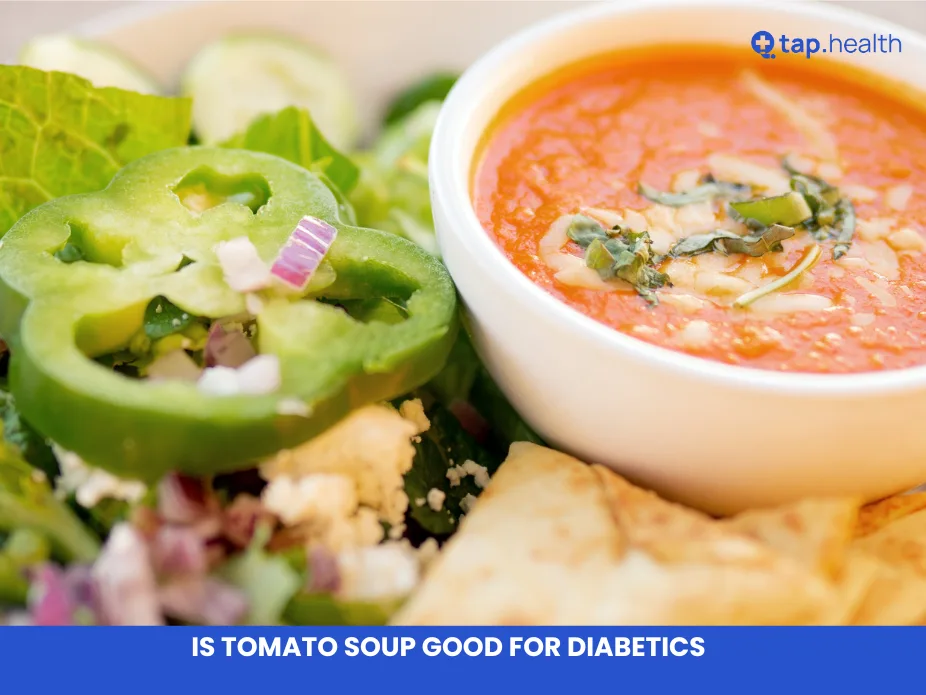Tomato soup is a beloved comfort food, but is it a smart choice for individuals managing diabetes? In this blog, we’ll explore the nutritional benefits, potential drawbacks, and how to make tomato soup a healthy part of a diabetic diet. With real-life scenarios, expert insights, and recommendations backed by research, this guide will help you understand if tomato soup is truly a good fit.
Understanding Diabetes and Its Dietary Needs
Diabetes requires a diet that stabilizes blood sugar, provides essential nutrients, and minimizes health risks. Foods with a low glycemic index (GI), high in fiber, and low in added sugars are preferred. Tomato soup, depending on its preparation, may fit well into this framework.
Nutritional Benefits of Tomato Soup
Low Glycemic Index
Tomatoes have a GI of 15, which is considered low, making tomato soup a smart choice for diabetics when consumed in moderation.
Rich in Antioxidants
Tomatoes are packed with lycopene, a potent antioxidant that helps reduce inflammation and oxidative stress, key issues for diabetics.
Heart Health Benefits
Tomatoes are high in potassium, which supports heart health by helping to regulate blood pressure, a common concern for people with diabetes.
Supports Weight Management
Low in calories but satisfying, tomato soup can be a valuable addition for those aiming to maintain a healthy weight, a crucial factor in diabetes management.
Is Tomato Soup Good for Diabetics?
Yes, tomato soup can be good for diabetics, but it depends on how it’s prepared.
What to Watch Out For in Tomato Soup
Hidden Sugars
Packaged tomato soups often contain added sugars that can spike blood sugar levels. Always check the label or opt for homemade soup.
High Sodium Levels
Canned and packaged soups can be high in sodium, contributing to hypertension. Look for low-sodium options or prepare your soup at home to control salt intake.
Portion Control
Even nutritious foods can affect blood sugar levels if consumed in large portions. Moderation is key to making tomato soup a healthy choice.
How to Prepare Diabetic-Friendly Tomato Soup
- Use fresh tomatoes and avoid store-bought varieties with added sugars.
- Add flavor with natural ingredients like garlic, ginger, or herbs instead of cream or butter.
- Opt for low-sodium seasoning.
- Enhance the fiber content by adding vegetables like spinach or carrots.
- Pair the soup with whole-grain bread or a small portion of protein like grilled chicken.
The Benefits of Tomato Soup for Diabetics
1. Low Glycemic Index (GI)
Tomato soup generally has a low glycemic index, especially if it’s made with fresh, whole tomatoes. The glycemic index (GI) is a measure of how quickly a food raises blood sugar levels. Foods with a low GI (55 or less) are digested more slowly and cause a slower rise in blood sugar, making them suitable for diabetics.
While canned tomato soups can sometimes have added sugar and preservatives that may affect the glycemic index, homemade tomato soup made from fresh tomatoes is a much better option for blood sugar control.
2. Rich in Antioxidants
Tomatoes contain lycopene, an antioxidant that has been shown to have protective effects against cardiovascular disease and certain types of cancer. Lycopene also helps reduce inflammation in the body, which is especially beneficial for diabetics who may be at higher risk for chronic conditions such as heart disease.
3. Supports Heart Health
Diabetics are at higher risk for heart disease, but the nutrients found in tomatoes—especially potassium, lycopene, and vitamin C—are known to support heart health. Potassium helps manage blood pressure, which is often elevated in individuals with diabetes. Lycopene may reduce the risk of developing heart disease by improving cholesterol levels and reducing blood vessel inflammation.
4. A Good Source of Fiber
Fiber is essential for managing diabetes because it slows down the absorption of sugar into the bloodstream, preventing spikes in blood sugar. While tomato soup isn’t packed with fiber, it still provides a moderate amount. Adding high-fiber ingredients like beans, lentils, or vegetables to your tomato soup can boost its fiber content and make it even more beneficial for blood sugar management.
5. Boosts Immunity
Tomatoes are a rich source of vitamin C, which plays a crucial role in strengthening the immune system. Diabetics are often more prone to infections due to compromised immune function, so incorporating immune-boosting foods like tomato soup can help support overall health.
Considerations When Eating Tomato Soup with Diabetes
While tomato soup can be a healthy addition to a diabetic diet, it’s important to consider the following factors to ensure it’s as beneficial as possible:
1. Watch Out for Added Sugar
Many commercially prepared tomato soups—especially canned varieties—can be loaded with added sugars. These added sugars can quickly increase the carb content of the soup, causing a spike in blood sugar. Always check the nutrition label for any added sugars or syrups. Opt for low-sodium, sugar-free, or unsweetened versions whenever possible.
Tip: When making homemade tomato soup, avoid adding sugar. You can sweeten it naturally with carrots, which have a mild sweetness, or other vegetables.
2. Be Mindful of Salt Content
Some store-bought tomato soups may contain high levels of sodium, which can increase your blood pressure and contribute to heart disease, a common concern for people with diabetes. Check the nutrition label for the sodium content, and choose low-sodium or reduced-sodium versions. You can also make your own tomato soup at home using fresh ingredients to control the amount of salt.
Tip: Add herbs like basil, oregano, or thyme for flavor instead of salt. Fresh garlic and onion can also enhance the taste without relying on excessive sodium.
3. Pair Tomato Soup with Protein and Healthy Fats
Tomato soup is typically low in protein and fats, so it’s a good idea to pair it with a source of protein and healthy fats to create a balanced meal. Consider adding a side of whole grain toast with avocado, or top your soup with a handful of tofu, chickpeas, or grilled chicken. These additions will make the meal more satisfying and help stabilize blood sugar levels.
4. Portion Control
While tomato soup can be part of a healthy meal, portion control is important, as even low-GI foods can cause blood sugar spikes if eaten in large amounts. Stick to a single serving, and be mindful of any other carbohydrate-rich foods you consume during the same meal.
How to Make a Diabetes-Friendly Tomato Soup
Making your own tomato soup at home allows you to control the ingredients and avoid excess sugar and salt. Here’s a simple, healthy recipe for a diabetes-friendly tomato soup:
Ingredients:
- 6 ripe tomatoes, chopped
- 1 medium onion, chopped
- 2 cloves garlic, minced
- 2 cups vegetable broth (low-sodium)
- 1 tablespoon olive oil
- Salt and pepper to taste
- Fresh basil (optional)
Instructions:
- Sauté the vegetables: In a large pot, heat the olive oil over medium heat. Add the onions and garlic, and sauté until softened and fragrant, about 3-4 minutes.
- Cook the tomatoes: Add the chopped tomatoes and vegetable broth to the pot. Bring to a simmer, and cook for 20-30 minutes, until the tomatoes are soft and fully cooked.
- Blend: Using an immersion blender, blend the soup until smooth. If you don’t have an immersion blender, you can transfer the soup to a regular blender, but be sure to let it cool slightly before blending to avoid splattering.
- Season: Season with salt and pepper to taste. Garnish with fresh basil if desired.
This homemade tomato soup is low in carbs, free of added sugars, and full of heart-healthy nutrients—making it an excellent choice for diabetics.
Side Effects of Tomato Soup for Diabetics
While tomato soup offers many health benefits, there are some potential side effects that diabetics should be aware of:
1. Acid Reflux
Tomatoes are acidic in nature, and some people may experience acid reflux or heartburn when consuming them. If you have a history of acid reflux or gastroesophageal reflux disease (GERD), you may want to consume tomato soup in moderation or avoid it altogether.
2. Increased Blood Sugar with Added Ingredients
Canned tomato soups, or soups made with added sugars, high-fructose corn syrup, or sweetened condensed milk, can cause an increase in blood sugar levels. Always read labels and opt for versions with no added sugars. Homemade tomato soup is the best option to control ingredients.
3. Sodium Sensitivity
If you’re sensitive to sodium or have high blood pressure, be cautious of canned tomato soups, which may be high in salt. Look for low-sodium options or prepare the soup from scratch to avoid excess salt.
What Is the Best Time to Take Tomato Soup?
Tomato soup can be enjoyed at any time of day, but there are a few considerations for optimal health benefits:
1. Lunch or Dinner
Tomato soup makes a great lunch or dinner option, especially when paired with a healthy source of protein or whole grains. This will help stabilize your blood sugar levels throughout the afternoon or evening.
2. Before or After Exercise
If you’re planning to exercise, a light serving of tomato soup with some added protein can serve as a great pre- or post-workout meal. The carbs from the soup can help refuel your body, while the protein helps in muscle recovery.
3. With a Balanced Meal
Since tomato soup can be low in protein, it’s best consumed alongside other nutrient-dense foods like whole grains, leafy greens, and healthy fats. Combining the soup with a balanced meal ensures you’re getting the proper nutrients to manage your blood sugar levels effectively.
Real-Life Scenarios
Ramesh from Mumbai:
Ramesh, 45, was diagnosed with diabetes but loved tomato soup. After consulting a dietitian, he started making homemade tomato soup with fresh tomatoes, garlic, and a touch of olive oil. He found it kept his blood sugar levels stable and added variety to his diet.
Priya from Chennai:
Priya, a homemaker, realized that store-bought soups were contributing to her rising blood sugar levels. She switched to homemade tomato soup, adding spices like cumin and turmeric for flavor and health benefits. The change not only improved her glucose levels but also pleased her family.
Read this : Is 800 Blood Sugar Normal?
Expert Contributions
Dr. Anil Desai, a leading nutritionist in India, emphasizes, “Tomato soup is an excellent addition to a diabetic diet if prepared thoughtfully. Fresh ingredients, portion control, and the absence of unhealthy fats and sugars are essential to reap its benefits.”
For more on diabetic-friendly recipes, visit NutritionIndia.
Recommendations Grounded in Proven Research
- Choose fresh tomatoes: They provide natural sweetness without added sugar.
- Focus on homemade preparations: Control ingredients for a healthier version.
- Monitor portion sizes: Stick to a single serving.
- Add protein or fiber: Pair with grilled chicken, legumes, or leafy greens for balanced nutrition.
Factual and Reliable Information
Research from the American Diabetes Association confirms that low-GI foods like tomatoes are excellent for diabetics. Studies also highlight the benefits of lycopene in reducing inflammation and improving heart health. However, they warn against high sodium and added sugars in processed foods.
Frequently Asked Questions (FAQs) on Is Tomato Soup Good for Diabetics?
Is tomato soup safe for diabetics?
Yes, when made with fresh tomatoes and without added sugars, tomato soup can be a safe and nutritious choice.
Can canned tomato soup be consumed by diabetics?
Canned soups often contain added sugars and high sodium levels, which are not ideal for diabetics. Opt for low-sodium, sugar-free versions or homemade soup.
How often can diabetics have tomato soup?
Tomato soup can be included in a diabetic diet 2–3 times a week when paired with a balanced meal and consumed in moderation.
What can be added to tomato soup for diabetics?
Additions like garlic, ginger, cumin, turmeric, spinach, and carrots can enhance the nutritional value of tomato soup without affecting blood sugar levels.
Is tomato soup beneficial for weight management?
Yes, it is low in calories and can be filling, making it a great choice for those managing their weight.



